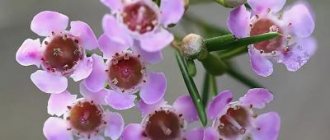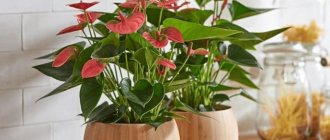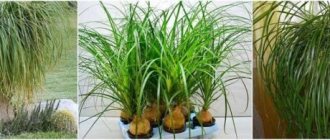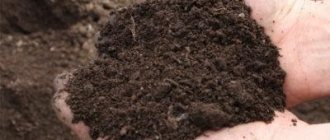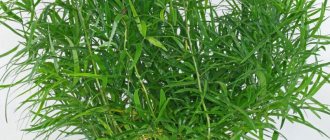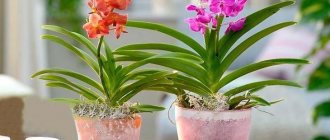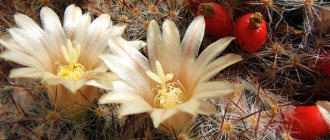Delicate, thinnest lace of shoots is asparagus. The plant is very undemanding and hardy, which is why it has earned the attention of home flower lovers. Recently, asparagus appears less and less in stores; it is being replaced by plants with brightly colored leaves. But a well-groomed flower is not at all inferior in decorative value to other plants, and if you show a little imagination, then from asparagus you can even make a unique decorative element that will decorate not only your apartment, but also your work space. And in order to grow a wonderful flower at home, you need to learn all the secrets of caring for it.
What indoor asparagus looks like of different types and varieties: photos and names of varieties
Among the representatives of the asparagus family, a special place is occupied by edible varieties of asparagus, shown in the photo, which are grown for gastronomic purposes:
Today, for their aesthetically graceful appearance, plants are used for interior landscaping, creating original cascading ikebana flowers, arranging bouquets and other flower arrangements.
The huge variety of species and varieties does not allow us to unambiguously answer the question of what homemade asparagus looks like, since specific features and characteristics are always inherent.
However, general external characteristics characteristic of the vast majority of plants of this family can be distinguished:
- Herbaceous shrubs, lianas.
- Flexible stems.
- Leaf shoots are needle-shaped.
- Small flowers in inflorescences.
- Single-seeded decorative berries.
This homely, sophisticated asparagus flower with its lush green color will add freshness to any room and fill the atmosphere with coziness.
Modern breeding science knows more than 200 species of ornamental asparagus. However, not every species can be found in flower shops or in the collections of professional flower growers.
According to experts, no more than ten species are cultivated and grown indoors or in open ground.
For greater clarity, all descriptions of asparagus species are supplemented with photos and official names, which will help you understand in detail the specifics of each member of the family:
The most famous is the densely flowered asparagus ( Asparagus densiflorus ) - a powerful plant with sparse cladodes-shoots, its leaves are transformed into awl-shaped scales. The height of the bush is insignificant - only 45 cm, but due to the elongated shoots (more than one and a half meters), its width exceeds 6-7 m.
The leaves (or so-called phyllocladies) are small, scale-like. Once a year, the plant pleases its owners with flowering, represented by compact inflorescences of miniature white flowers. A week later, these delicate “fireflies” are replaced by round fruits of a noble burgundy color.
Breeders have developed excellent varieties of this asparagus:
"Myersii" - with distinctive shoots stretching upward.
"Sprengeri" - with characteristic long drooping branches.
's asparagus (Asparagus Meyeri) leaves are arranged much more densely in the form of a spindle. The herbaceous shrub is not large in size. Its height barely reaches 40 cm, but the branched shoots grow significantly in width - more than 5.5 m. This flower is popularly nicknamed “fox tail”, which is explained by the location of the ovaries, which gives splendor to each stem.
To figure out what this “fluffy” asparagus looks like, take a look at the photo, and you will certainly have associations with forest fur-bearing animals - after all, the “tails” in this case are shown in green color from the pot.
Crescent asparagus (Asparagus falcatus) is an excellent hanging plant that is easy to care for. It got its name due to the shape of the leaves, which resemble “sickles” with a rounded bend.
The dimensions of these slightly corrugated phylloclades are small: 5 cm in length and up to 2 cm in width. The distinctive properties of the plant are its rapid growth and cold resistance. Because of these features, this type is most often used to decorate verandas and glazed balconies, where the temperature is not always warm.
of pinnate asparagus (Asparagus plumosus) are especially elegant , which are wrapped in miniature thread-like leaves resembling scales collected in bunches.
During the flowering period, this type of indoor openwork asparagus produces tiny white flowers, which smoothly give way to dark blue berries. The fluffy, scale-like structure of the plant is widely used to decorate bouquets and ikebana flowers or to create interior partitions and decorative screens.
Just look at the photo of beautiful indoor asparagus species, and their sophisticated lace silhouette in a rich green color will certainly provoke the imagination to create a new decorative composition using them:
Along with indoor representatives, experienced gardeners grow garden specimens of the plant. The places where they grow can be open ground in summer cottages, greenhouses, and front gardens. Changeable summer weather with its characteristic slight coolness or drought is not an obstacle to the normal development of this flower.
The main garden species of asparagus shown in the photo is asparagus asparagus (Asparagus asparagoides var. myrtifolius).
For more than a decade, it has been widely used as decorative greenery in bouquets. Due to its unpretentiousness and beautiful appearance, many hybrid interpretations of it have been developed today.
A description of the varieties of asparagus with official names and photos will form a general idea of this wonderful representative of the flora:
Asparagus officinalis , popularly referred to as medicinal asparagus, is a tall herbaceous plant that can grow over 1.5 m in height. Branched thin stems bend from many sharp scaly leaves. During flowering, the plant is decorated with miniature amber flowers.
The next cold-resistant bush is Asparagus asparagus L. , which can often be found under the name white asparagus. This variety of asparagus is used for making medicines and also in the culinary industry. Externally, the plant has more powerful outlines than its decorative relatives. The height of individual specimens can be more than 2 m.
Green asparagus is considered a culinary variety of asparagus. A branched stem, small leaves, miniature flowers and dark blue oval fruits are its characteristic features.
The nutritious parts of the plant are considered to be sprouts, which are collected from May to June. The presence of a large amount of vitamins, fiber, and antioxidants was the main reason for growing this variety.
Growing asparagus at home: light, temperature and soil
The indoor ornamental plant asparagus is one of the unpretentious and grateful representatives of the flora. It is enough to provide basic living conditions, and the flower will delight its owners with a luxurious bright green crown and sophisticated inflorescences.
Sun-loving shrubs feel comfortable on the western and eastern sides of the apartment. Since this location not only provides them with a lot of light, but also protects them from long-term direct exposure to sunlight. If the created interior composition with asparagus will look more harmonious in a southern room, then it is advisable to place it away from the window. From late spring to early autumn, such a flower can be left on open verandas or balconies, the only warning is to avoid heavy rainfall and drafts.
When growing gourmet asparagus in ordinary home conditions, there are no special temperature requirements. According to experts, the temperature should be normal room temperature, cooler in winter, but not lower than 10°C.
Therefore, in the hot summer at 25°C, the plant will feel uncomfortable, and the leaves may even dry out. In such situations, even an increased level of air humidity will not be able to restore the fading stems - they will have to be removed.
Air humidity: does not matter. However, if the flower grows in extreme dryness, it will soon turn yellow and dry out. To obtain a more saturated and bright color of the leaves, you should regularly spray this ornamental bush.
Particular attention should be paid to the quality and composition of the soil. Substrate: flower soil mixture with 1/4 loam. If you have experience in preparing the soil yourself, you can mix turf and leaf soil, and also add a small amount of peat and sand.
By creating such a “cozy” habitat, gardeners prevent situations in which asparagus gradually dries out, while the plant, with its thick openwork crown and rich green color scheme, will only touch and delight.
Pests
Flower pests are spider mites and scale insects . Spider mites can be recognized by their thin webs on the branches, and scale insects by brown or yellowish tubercles on the stems. These insects, feeding on the juices of the plant, weaken it.
Spider mite on a plant
Vermitek , Fitoverm, will help get rid of pests . Asparagus does not tolerate treatment with chemicals very well, so it is better to regularly inspect the plant in order to get rid of pests in a timely manner without the use of insecticides.
Proper care of indoor asparagus
Proper care of indoor sophisticated asparagus is possible even for novice gardeners, since minimal knowledge and little effort will delight you with excellent results.
Proper soil irrigation is the key to healthy and active growth of the green “pet”. Watering: constant moderate humidity. But it is worth considering the seasonality and cycles of life processes in the plant. Therefore, abundant and frequent irrigation should be in summer, and moderate in winter, when the flower is dormant. It is better to use the bottom watering technique, which allows you not to harm fragile trunks and leaves, and accumulate excess moisture in the trays.
It is important to choose settled water at room temperature as a liquid for such procedures. Spraying in hot and dry weather will be beneficial for the general condition of the bush, which should be done in the early morning or in the evening.
A significant point in caring for the decorative asparagus flower in the usual home conditions is proper and high-quality fertilization of the soil. Such feeding should be carried out weekly in the summer, and once every 4 weeks in the winter. When choosing fertilizers, you should give preference to universal complex mineral mixtures, which can be periodically replaced with weakly concentrated organic additives. Important! It is sensitive to chemicals, so it is better not to experiment with unverified manufacturers of mineral fertilizers.
What to do if the decorative asparagus turns yellow and crumbles?
Despite the unpretentiousness and hardiness of asparagus, when growing it, inexperienced gardeners may encounter various diseases and problematic situations. Among these are possible:
- Spots on leaves.
- Dark edges.
- Shedding and yellowing of foliage.
- Pale color of the leaves.
- General wilting of the flower.
Each of the listed unpleasant cases has its own causes and methods of “treatment”.
So, in order to determine what to do when decorative asparagus turns yellow and crumbles, you need to identify unfavorable factors and eliminate them. In some situations, this will be enough to completely heal the damaged flower.
Hot temperatures and increased dry air are contributing factors to wilting and yellowing of the foliage of the bush. Therefore, the solution here involves a forced decrease in temperature and an increase in humidity using traditional methods and special devices.
An alternative solution would be to change the location away from the switched on battery or heater.
Medicinal properties
Asparagus is able to purify the air and destroy pathogenic bacteria. So this flower is recommended for growing for people suffering from lung diseases.
But the berries are mostly poisonous. They should not be eaten, otherwise it will end in diarrhea and vomiting.
True, this does not apply to asparagus or vegetable asparagus, which is capable of:
- reduce blood pressure;
- relieve a migraine attack;
- reduce swelling;
- remove toxins from the body.
It is advisable to consume asparagus for people suffering from dropsy, cholesterol plaques and kidney problems.
Indian traditional medicine widely uses asparagus racemosus root to solve female and male problems.
Densely flowered asparagus will help the wound heal faster and the fracture heal.
Why do indoor asparagus leaves turn yellow, dry out and fall off, what to do in such situations?
The answer to the question of why the thin leaves of exquisite asparagus turn yellow may be excessive exposure to bright sunlight, as a result of which the plant develops a burn and characteristic yellowness.
Dry soil is another reason why the attractive indoor asparagus flower turns yellow. The frequency and intensity of water procedures should be reconsidered. However, you shouldn’t overdo it here either, since excess moisture contributes to rotting of the root system, which leads to wilting and death of the flower.
Therefore, it is important to find the “golden mean” in the watering regime in order to achieve a healthy green shine of stems and leaves.
Beginners often wonder why homemade asparagus dries out, when the answer may be quite simple - lack of lighting. In such cases, the course of treatment is elementary and involves changing the location of the flower pot with greater intensity of sunlight. As for dried branches, they should be cut off, since they cannot be “restored” and only spoil the appearance of the indoor “handsome”. By following these recommendations, even a beginner can ensure that the flower will soon delight you with new succulent shoots.
The reason why the bright green asparagus leaves turn yellow and fall off may also be due to harmful insects, which, by parasitizing, disrupt the normal life cycles of the plant. Among the pests of this plant, the most frequent “guests” are:
Aphid.
Spider mite.
Shield.
Aphids, which appear on an ornamental bush after “walks” in the garden in the summer, not only deplete it, but also cause the leaves to dry, wither and fall off. The only way to “expel” these pests is to treat them with special insecticides and provide comfortable growing conditions for the bush to renew lost “strength”.
Among these modern drugs, the most effective will be:
- "Agravertine".
- "Confidor".
- "Etisso."
- "Talstar."
- "Bazudin."
In a situation where asparagus is left for a long time in a dry, poorly ventilated room, there is a high probability of spider mites appearing. These parasites, feeding on the juice of the stems, deplete the plant, as a result of which the leaves of indoor asparagus wither and turn yellow. The question of what to do in such situations and how to deal with uninvited “guests” is one of the most frequently asked by beginning gardeners.
As a treatment, it is worth spraying the crowns of the bush with a concentrated solution of Actellica, and subsequently, for prevention, carry out irrigating procedures with warm water, covering the soil.
Parasitism by scale insects may also explain why asparagus leaves suddenly turn yellow. The list of what to do with this problem will be similar to the actions when fighting spider mites. However, you should first clear the stems of insects, which resemble brown convex plaques. An alternative folk method of getting rid of such pests can be a soap solution, but the difficulty will only lie in its subsequent washing off by repeated spraying with clean water.
Experienced flower growers, having analyzed the habitat and basic care conditions, can immediately determine the reasons for the deterioration in the “well-being” of the home “lace” bush. And this is already a large part of the path to full recovery and its active growth.
Possible problems
In fact, the only problem with replanting is the powerful root system . This makes it quite difficult to remove the plant from the pot.
As mentioned above, this issue can be solved by preliminary watering with plenty of water or using a knife, which is carefully passed along the edges of the pot.
The situation is somewhat more complicated if the roots of the plant stick out from the drainage holes of the pot. If you are careless, they can be damaged, which will lengthen the acclimatization process and complicate rooting. In this case, abundant watering will also help . Water is poured in several stages so that it thoroughly saturates all layers of soil. Wet asparagus roots are more elastic and will be easier to both remove from the pot and untangle for planting.
Important! You should be careful when dividing the bush. Many species of this plant are prickly and you can injure your hands during planting.
The procedure for transplanting asparagus at home
An important step in the process of growing ornamental asparagus is its proper replanting, which should be done if necessary.
There are several situations for which this procedure must be carried out:
- After purchasing in a store.
- The flower has “outgrown” the pot.
- Changing the soil to a more fertile one.
- There are pests in the soil.
In addition, according to experienced gardeners, an adult plant that has reached the age of five must be replanted regularly at least once a year. This will have a beneficial effect on the active growth and development of the green “pet”.
The process of transplanting decorative asparagus in familiar home conditions is not particularly complicated, so even a beginner can perform it correctly. The entire sequence of the procedure covers the following steps:
- Choosing a new pot.
- Preparation of nutritious soil.
- Preparing drainage for the container.
- "Migration" of the bush.
- Careful flower care.
The new container in which asparagus will grow should be slightly larger than the previous one. The first obligatory layer in the pot is drainage, which performs a critical function for normalizing the level of moisture in the soil.
Particular attention must be paid to the preparation of the substrate, since it is its composition that will largely affect the active growth and development of the flower, or will lead to their slowdown. For inexperienced gardeners, it is better to use a universal mixture, which is available at any flower shop.
And those who understand the technique of preparing the substrate can get it by mixing leaf soil, humus and sand.
After carefully transplanting a flower to a new “residence,” it is important to carefully and attentively care for it for the first two weeks, after which you can add small doses of fertilizer to the “diet” and use water “baths” for the leaf crown. It is better to transplant in the spring, when the plant is at the stage of active growth.
Do I need to prune asparagus and how to prune it?
Many amateur gardeners are wondering whether it is necessary to periodically trim overgrown asparagus, and whether such manipulation will be useful. This procedure is necessary because it can help achieve better aesthetic results and increase the level of decorativeness of the flower.
It is worth pruning indoor asparagus in the spring. It is then that the plant has enough strength to renew and quickly replace dried out old stems. After removing the “bald” branches, the flower actively produces young shoots, which give the bush greater splendor and attractiveness.
Growing ornamental asparagus from seeds at home
Creating indoor greenhouses and decorative compositions in the interior is impossible without mastering the technique of propagating sophisticated asparagus in familiar home conditions. However, there are no difficulties in this process, and even a lack of experience in floriculture will not be an obstacle to achieving excellent results.
In practice, the following reproduction methods are used:
- Seeds at soil temperatures from 20 to 25 ° C.
- Young cuttings.
- Dividing the bush.
Each technique has its own advantages and implementation features, once you understand them, you can easily grow a luxurious, lush bush with lacy branches and elastic stems.
The most durable of all alternative methods is the process of propagating asparagus from collected seeds from a mature bush at home. Planting material is formed in the ripened fruits of the flower, usually in winter. And here the procurement of seeds should not be put on the back burner, since their greatest productivity occurs in the first days after collection.
First you need to place the seeds in a prepared mixture of peat and sand, which should be regularly moistened and covered with glass or polyethylene. It is important that the seeds are covered with soil; they germinate in the dark.
The germination rate of seedlings depends on daily soil ventilation, temperature conditions and proper irrigation. It is necessary to maintain the same temperature, trying not to exceed +21...+22°C.
Condensation that periodically appears on the glass indicates the need to “refresh” the air. Therefore, it is worth raising the insulating elements and allowing the soil to fill with oxygen. This vital action will help speed up the growing of ornamental asparagus from collected seeds at home and give young seedlings energy for germination.
In these comfortable conditions, the first shoots will appear within 4 weeks. As soon as the seedlings reach 10 cm, they can be planted in separate miniature pots with soil, which is the same in composition as for adult relatives.
Growing elegant asparagus using seeds will require a little patience, since only after six months can you evaluate the results of your efforts.
Reproduction
Asparagus can be propagated in three ways:
- dividing the bush;
- cuttings;
- seeds.
You can use any of them.
Dividing the bush
It is better to do this in the spring during transplantation. When you remove the bush from the old pot, carefully divide the roots into two or more parts, depending on the size of the pet. Plant each division in a separate pot, covering it with regular substrate, as described above.
Cuttings
You also need to take cuttings when spring comes. Select the strongest shoots and cut cuttings from them at least 10 cm in height. Plant for rooting in damp sand. Stretch plastic film on top, creating greenhouse conditions. Place in a warm, bright place. Remove the film every day to ventilate and moisten the soil. When you notice the appearance of roots, transplant to a permanent place.
Seeds
Seed material is not stored for a long time, so seeds should be sown immediately after collection. This usually happens in January-February. Sometimes you manage to capture March. Prepare a container by filling it with soil mixture, moisten it, and place the seeds on top at some distance from each other. Cover with glass. Move to a bright place, providing 20 degrees of heat.
Remove the glass from time to time to ventilate the planting and moisten the substrate. When the sprouts reach 10 cm, plant them in a larger box. And at the beginning of summer, plant them in separate flowerpots with a diameter of no more than 10 cm.



